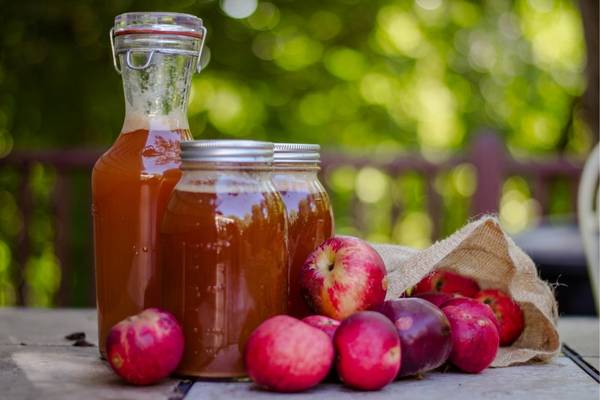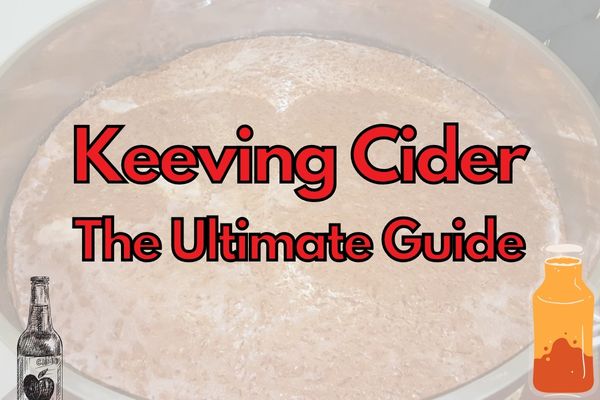Many craft hard cider makers prefer clear cider over cloudy cider for aesthetic reasons. While cloudy cider may still taste delicious, clear cider can be more visually appealing.
But How do you clear a hazy cider?
Simply put, clearing your hard cider means removing the yeast and other particles that can make it look cloudy or hazy.
This process makes your cider look and taste better, but many people find it daunting. If you’re ready to take the plunge and learn how to clear hard cider, keep reading!
We’ll cover all the basics, from why it’s important to how to do it. So grab yourself a glass of cider and let’s dive in.
1. The Appeal of a Clear Hard Cider
As a craft hard cider maker, it’s important to understand the importance of clarifying your hard cider. While it may seem like a purely aesthetic choice, having a clear cider helps to remove any compounds that may cause off-flavors or bitterness.

Additionally, most people prefer the look of a clear cider over a cloudy one. There are several cost-effective ways to clarify your cider, including aging, cold-crashing, fining, and filtering. Each method has its own advantages and disadvantages, and it’s up to you to experiment and find which works best for your specific recipe and preferences.
Whether you choose to use pectic enzymes to remove haze-causing compounds or simply rely on aging and filtering, clarifying your hard cider can help to bring out the best flavors and make sure your beverage looks as good as it tastes.
3. Using pectic enzyme to remove pectin haze
Pectic enzyme is a great way to remove pectin haze from hard cider. Pectin is a complex carbohydrate that gives structure to fruit, but can cause cloudiness in cider. Pectic enzyme breaks down the pectin into smaller, more easily passable particles, which reduces haze.

It’s important to add pectic enzyme before fermentation, as alcohol can reduce its effectiveness. The recommended temperature for adding pectic enzyme is between 80F to 100F, but always check the manufacturer’s instructions.
It’s also worth noting that pectic enzymes are often used during the crushing and pressing of fresh apples to increase juice yield.

While it’s not necessary to use pectic enzyme to make hard cider, it can be beneficial for those who want a clearer product. Ultimately, it’s up to the individual cider maker to experiment and find what works best for them.
4. Aging: The Natural Way to Clarify Hard Cider
One natural way to clarify hard cider is through aging. As hard cider is left to sit and age, sediment and yeast settle to the bottom of the container.

This process can take up to several months, but the result is a clear, smooth cider. During the aging process, it is essential to keep the hard cider in a cool, dark place, away from sunlight and fluctuations in temperature. The ideal temperature for cider to age is between 50-60°F.
While this method may take longer than others, it is an easy and affordable way to clarify hard cider without the need for additional equipment or additives. Additionally, aging can enhance the flavor and complexity of the cider, resulting in a more nuanced taste.
Overall, if time is not an issue, aging may be the perfect method for those looking for a natural way to clarify their hard cider.
5. Cold-Crashing: An Inexpensive Method to Reduce Suspended Solids
For craft hard cider makers looking for a cost-effective means to clarify their hard cider, cold-crashing is an easy and inexpensive method to reduce suspended solids.
By placing a hard cider in the refrigerator, suspended solids will drop to the bottom of the container, resulting in a clearer hard cider. Cold-crashing can be done in conjunction with aging, and ideally in glass or stainless containers like carboys or kegs.

However, it is important to remember that cold-crashing will create pull-back through the airlock if the hard cider is being aged with an airlock in place. This method is a good option to use alongside other clarification methods, such as fining and filtering.
In terms of personal preference, some cider makers may prefer a slightly cloudy cider, while others may prefer a crystal-clear look. By experimenting with different clarification methods and techniques, cider makers can determine what works best for them and their desired level of clarity.
6. Fining: Using Gelatin to Attract Suspended Solids and Clarify Hard Cider
Fining is a simple and inexpensive way to make hard cider clear. One effective way to do this is by using unflavored gelatin as a fining agent. Gelatin attaches to the suspended particles in the cider and settles them to the bottom of the container, leaving a clear liquid on top.
To use gelatin, one should boil a cup of water and then remove it from heat and let it cool. Add 1 tsp of gelatin and let it sit for 20 minutes.
Then, stir the solution into the cider slowly to avoid introducing oxygen. Another method would be to add the solution to a separate container and rack the cider onto it.
Once mixed, let the cider sit for 3-5 days until it is very clear with visible sediment on the bottom. Lastly, rack the cider off of the settled sediment for bottling or kegging.
It is important to note that gelatin is an animal product, so for vegan cider, one can use a non-animal fining agent like isinglass. In conclusion, fining is an easy and practical method to make hard cider clear, and gelatin is one exemplary choice of fining agent.
7. Keeving – The Art of Starving Your Yeast!
Keeving is an ancient technique used to make cider that results in a natural, low-alcohol, and sweeter, much more clear, cider.
This process was developed in Ireland and France centuries ago and involves allowing the juice to ferment slowly over several months.
The result of this method is a complex flavor profile with notes of sweetness that can be enjoyed by both novice and experienced cider drinkers alike.

The keeving process has been around for hundreds of years, though it wasn’t until recently that its popularity began to rise again among home brewers.
It all started when Irish farmers noticed that their apples, high in calcium, were naturally sweetening during fermentation due to the presence of natural pectinase enzymes released from the apple skins as they broke down during pressing.
These enzymes cause pectin molecules in the juice to break apart and form a pectin gel with the calcium. They racked it off and got a clearer, sweeter, cider!
8. Filtering: The Final Method for Clarifying Hard Cider
Filtering is the final and most effective method for clarifying hard cider. This process requires equipment, but it is worth it if you are looking for a crystal-clear cider.
While this method does require use specialized equipment such as fine mashed pressurised filters etc. it does offer great benefit being able achieve crystal clear clarity and the exact sweetnes you want at any point in fermentation much faster than other traditional methods available out there today.
There are various types of filtering equipment available in the market, such as gravity-fed and pump-fed filters.
Choosing the right filtering equipment will depend on what kind of cider you are making and the level of clarity you want to achieve.
The filtering process involves passing the cider through multiple filters with smaller and smaller micron ratings, removing suspended solids and producing clear cider. The process may take some time, but the result is worth the effort.
Additionally, filtering allows for consistent clarity across batches, making your cider more visually appealing to customers. If you are a craft hard cider maker, filtering may become your preferred method for clarifying cider due to its efficiency and the consistent clarity it produces.
9. Equipment Needed for Successful Filtering
As a craft hard cider maker, you may want to use filtering as a cost-effective and easy way to clarify your hard cider. However, to ensure successful filtering, you will need specific equipment.
Firstly, you will need something to filter through, such as a carboy or keg. In addition, you will need filters of various sizes with a smaller micron rating. Gravity-fed systems can work, but a CO2 or pump-powered system is more efficient.
You will also need tubing to move the cider from the carboy/keg through the filters and into another container or directly into bottles. Optional equipment includes a lock for the end of the tubing to reduce the mess and an auto-siphon tool to simplify the racking process.
Overall, filtering takes longer than other clarifying methods. However, it results in a crystal-clear and pleasing appearance to most viewers. It’s up to you to choose what equipment works best for your hard cider clarifying process.
10. Personal Preferences: Choosing Your Preferred Clarity Level
When it comes to cider clarity, personal preference plays a big role in deciding how far a cider maker wants to go to make their hard cider crystal clear. Some people prefer their cider to be slightly cloudy, as this can indicate that the cider is less processed and still contains some of the natural flavors and textures of the fruit.

On the other hand, others prefer their cider to be completely clear, as this can give it a more polished appearance and can even affect its taste.
It’s important for a cider maker to decide on their preferred level of clarity before starting the clarification process, as this will determine which method they choose to use.
If a cider maker prefers a slightly cloudy cider, they may opt for a simpler method like aging or cold-crashing.
However, if they want a completely clear cider, they may need to utilize more advanced and costly methods like fining or filtering. Ultimately, the choice lies with the cider maker and their personal tastes.
Conclusion: Experimentation and Finding What Works Best for You
In the end, the best way to clear hard cider will depend on various factors, including the specific cider maker’s preferences and available resources. They may find different methods of clarification, such as cold crashing, fining agents, or racking, which works best for them. The key is to experiment and find what yields the desired results.
Moreover, it may also be beneficial to try out different yeast strains to achieve the intended flavor profile, depending on one’s objectives for the cider. Ultimately, the important thing is to have fun and enjoy the process of making hard cider.
With so many choices to make, from the kind of apples to the yeast selection, one can create a cider that is unique and satisfying.
Whether making cider for personal consumption or to share with friends, the joy of experimentation and discovery will make the final product all the more enjoyable. So, embrace the adventure and find what works best for you!
References
https://scottlab.com/cider-clarification-101





